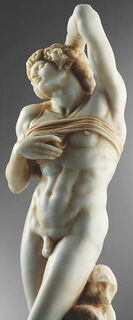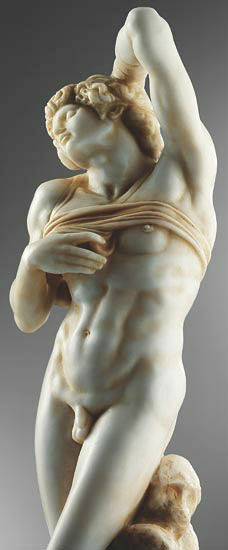Sculpture "Dying Slave" (1513), artificial marble reduction
Sculpture "Dying Slave" (1513), artificial marble reduction
Quick info
artificial marble | handmade | reduction | height 30 cm
Detailed description
Sculpture "Dying Slave" (1513), artificial marble reduction
Pope Julius II commissioned Michelangelo to create this life-size figure, and he gave the artist no restrictions. Michelangelo created a symbol for the earthly bondage of human beings and the freedom of art. Despite its manifold expressive gestures, the figure cannot step out of the block of marble. He remains a slave to his existence. However, the great opulence with which Michelangelo shaped every fibre of the body and the almost voluptuous movement convey a different message: even if the human being is constrained, the spirit and art are free! Alongside the "David", it is probably the "Dying Slave" that established Michelangelo's legendary reputation.
Original: Musée du Louvre, Paris.
Reduction. Cast in artificial marble. Height 30 cm.
About Michelangelo Buonarroti
1475-1564
Michelangelo depicted pain and despair but also hope in his prehistory of mankind: the Sistine Chapel in the Vatican. When he created these vaulted frescoes between 1508 and 1512, the main representative of the High Renaissance and pioneer of Mannerism was already playing a central role in Italian artistic and intellectual life as a sculptor and painter.
Michelangelo Buonarroti was born in Caprese, Tuscany, in 1475. He trained as a painter under Domenico Ghirlandaio, and as a sculptor probably under Bertoldo di Giovannis, whereby the study of antiquity was a major influence.
From 1496 to 1501, Michelangelo worked in Rome, where among other projects he created the "Pietà" for St Peter's Basilica. Until 1504, he worked in Florence on the monumental statue of "David", which still shows the close connection to antiquity. The following sculptures mark the transition to Mannerism through intense moments of movement.
In 1505, Michelangelo received the commission for the tomb of Pope Julius II. However, it was only completed in a reduced way after his death in 1513 because the stubborn artist could not come to an agreement with the client. The "Bound Slaves" and "Moses" were created in 1516. He was to work as an architect for the Medicis but was unable to realise the planned building and instead implemented the design he had developed in the staircase of the Biblioteca Laurenziana in Florence, starting in 1521.
As of 1534, Michelangelo lived in Rome for good.
Michelangelo's late work is characterised by an intensive preoccupation with religious themes but also with architectural plans, such as the supervision of the construction of St. Peter's Church or the Palazzo Farnese. Through his letters and sonnets, we can also discover Michelangelo the poet, who died in 1564.
Marble powder is polymer-bonded. Artificial marble is characterised by a fine white surface that appears very similar to marble.
(Rebirth). The term describing art from around 1350 until the 16th century.
A mindset that developed in Florence in the late 14th century that was retrospectively classified as rebirth of the classical ideals of Greek and Roman antiquity. During the 15th and 16th centuries, the Renaissance spread first over Italy and then all over Western Europe and determined the entire artistic creation. Brilliant artists such as Donatello, Leonardo da Vinci, Michelangelo, Raphael, Dürer, Holbein, Cranach and Fouquet created their immortal works by following the humanistic premises and placing the human being in the centre of all thinking.
Renaissance experienced its heyday in literature through dramatic works and poems of William Shakespeare.
At the end of the 16th century, the Renaissance had to give way to the opulence of baroque, before its ideas experienced a rebirth in the classicism of the 18th century.
A true-to-the-original reproduction of an artwork in the same size and with the best possible material and colour uniformity.
The mould is usually taken directly from the original so that the replication reproduces even the finest details. After casting the replication, using the most appropriate method, the surface is polished, patinated, gilded or painted according to the original.
A replication of ars mundi is a recognizable copy of the original.
A plastic work of sculptural art made of wood, stone, ivory, bronze or other metals.
While sculptures from wood, ivory or stone are made directly from the block of material, in bronze casting a working model is prepared at first. Usually, it is made of clay or other easily mouldable materials.
The prime time of sculpture after the Greek and Roman antiquity was the Renaissance. Impressionism gave a new impulse to the sculptural arts. Contemporary artists such as Jorg Immendorf, Andora, and Markus Lupertz also enriched sculptures with outstanding works.






